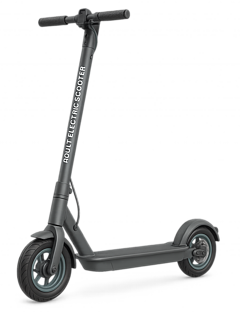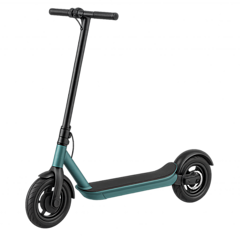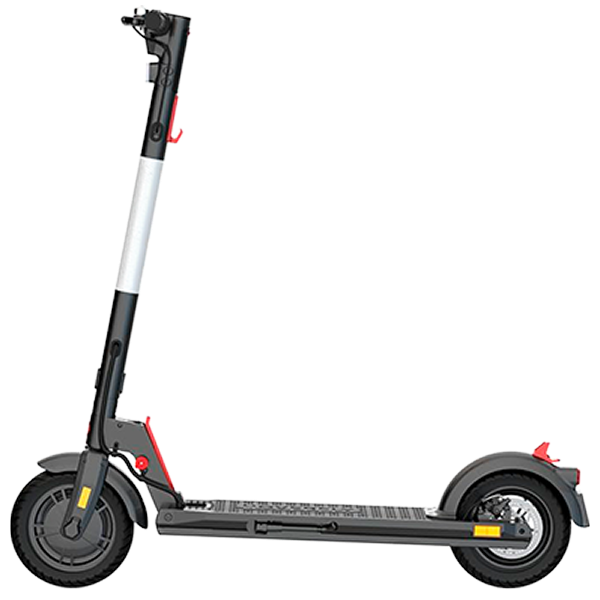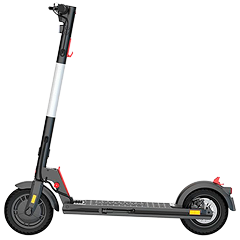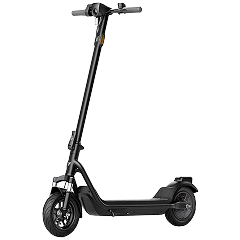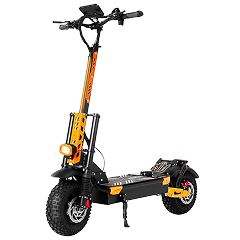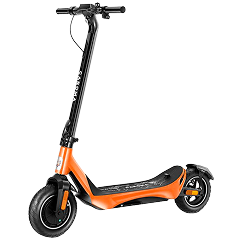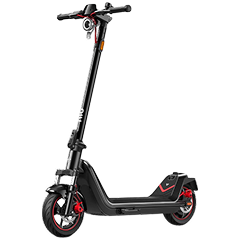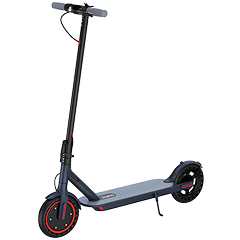You’re running late for work, your train is pulling into the station, and you need to sprint up two flights of stairs carrying your electric scooter. This is where the weight of your ride becomes very real, very quickly.
Lightweight electric scooters solve the fundamental problem that has plagued commuters since day one: how do you get genuine portability without sacrificing everything that makes a scooter useful? The answer involves understanding exactly what you’re willing to trade off and what you absolutely cannot compromise on.
When we talk about “lightweight” in the scooter world, we’re generally looking at anything under 40-45 pounds. To put that in perspective, the average electric scooter weighs around 50-60 pounds. That 10-20 pound difference becomes massive when you’re the one doing the lifting.
But lightweight scooters come with their own set of challenges. Less weight usually means smaller batteries, weaker motors, and sometimes flimsier construction, and the trick is finding the sweet spot where portability meets practicality.
Understanding E-Scooter Weight Categories
Lightweight scooters fall into three main categories, each with distinct characteristics and trade-offs.
Ultra-Light (Under 30 lbs)
These featherweight champions prioritize portability above all else. You can genuinely carry them with one hand, toss them in a car trunk, or haul them up stairs without breaking a sweat.
But there’s a catch. You’re technically looking at smaller batteries (144-300 Wh), modest motors (250-350W), and ranges that hover around 7-15 miles in real-world conditions. Some upper limits feel higher than the class, but this is because certain brands have gone out of their way to give maximum returns on investment in ultralight packages.
Here’s an overview of the specs to expect from real-world verified data:
Ultra-light scooters work brilliantly for short commutes, last-mile connections, or situations where you’ll be carrying the scooter frequently. They’re perfect for apartment dwellers who need to carry their ride up several flights of stairs or commuters who use multiple forms of transport.
Light (30-39 lbs)
This weight range offers the best balance for most riders. You get meaningfully larger batteries (216-624 Wh), more powerful motors (250-1000W), and ranges that can stretch to 30 miles. The extra 10 pounds compared to ultra-light models translates to noticeably better performance and features.
Here’s an overview of the specs to expect from real-world verified data:
Light scooters can handle longer commutes, moderate hills, and provide enough power reserve that you won’t feel like you’re constantly nursing the throttle. They’re still manageable to carry, though you’ll definitely feel the weight difference during longer hauls.
Lightweight (40-45 lbs)
At the upper end of lightweight, these scooters push the boundaries of what’s considered portable while delivering performance that approaches full-size models. Battery capacities of 360–650 Wh and motors in the 500W+ range become common. Some even feature dual suspension, larger wheels, or premium build materials.
Here’s an overview of the specs to expect from real-world verified data:
The trade-off is obvious: 45 pounds is getting into territory where casual carrying becomes a workout. But for riders who need lightweight features occasionally while prioritizing daily performance, this category delivers.
The Ideal Weight: As a rule of thumb, if you want an electric scooter that you can carry without struggling, aim for a scooter that’s no more than 25% of your body weight. Any heavier and you’ll dread every lift. For example, if you weigh 160 lbs, a 40-lb scooter is about your limit for easy carrying.
Folding Mechanisms and Portability
Weight is only half the portability equation. How a scooter folds and its dimensions when collapsed often matter more than the actual pounds when you’re navigating tight spaces or crowded transport.
Basic Stem Folding
The most common folding mechanism uses a lever at the base of the stem to fold the handlebars down toward the deck. This creates a triangular shape that’s functional but can be awkward to carry. The weight distribution becomes uneven, with most of the mass concentrated toward the rear.
Stem folding is quick and simple, usually taking less than 10 seconds. The downside is that folded dimensions aren’t particularly compact, and finding a comfortable carrying position takes some experimentation.
Cantilevered Joints/Parallel‑stem Joints
More sophisticated lightweight scooters use cantilevered joints that fold the stem parallel to the deck, creating a flat, rectangular package. This dramatically improves weight distribution and makes the scooter much easier to carry or roll when folded.
The folding process takes longer and often involves secondary safety latches, but the result is worth it. Cantilevered joints can reduce folded height by up to 33% compared to basic stem folding, making a real difference in storage and transport.
Collapsible Handlebars
Some lightweight scooters take portability further with handlebars that fold inward, parallel to the stem. This feature can reduce folded width by up to 70%, transforming a scooter that’s awkward to maneuver into something genuinely compact.
Collapsible handlebars come in two varieties: screw-type that require 20-30 seconds to fold but provide rigid connection, and quick-release that fold instantly but may develop play over time. Both have their place depending on how often you’ll use the feature.
Telescopic Stems
Adjustable-height stems serve double duty: they let you customize the riding position for comfort and can reduce folded length when fully collapsed. This feature particularly benefits households with multiple riders of different heights.
Quality telescopic mechanisms include clear height markings and strong locking systems. Cheap versions can develop wobble or even collapse under load, which is why this feature is worth paying extra for when done properly.
The Battery vs Weight Trade-off
The biggest challenge in lightweight scooter design is battery capacity. Lithium-ion cells have fixed energy density, meaning more range requires more cells, which means more weight.
Battery Capacity Reality Check
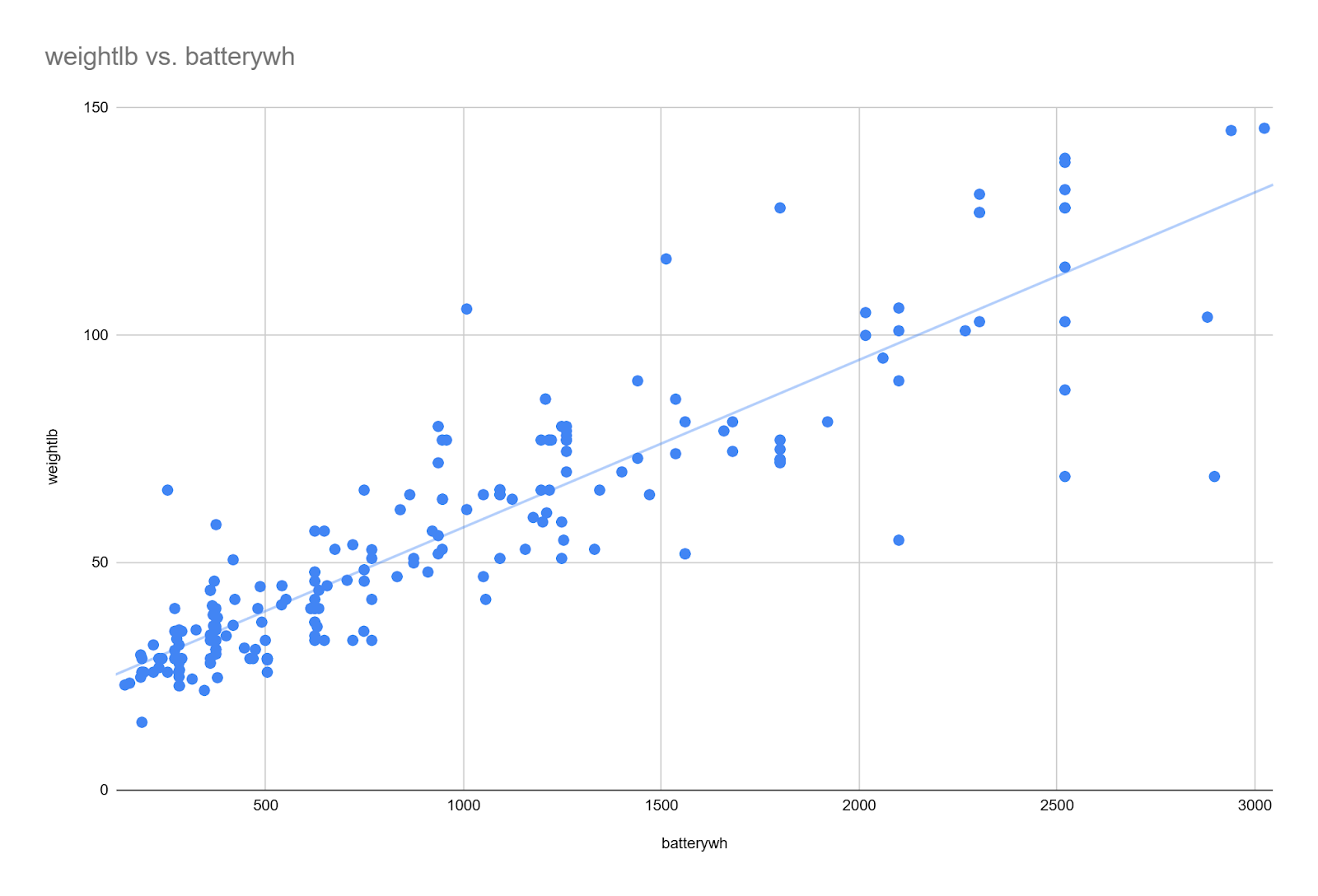
As shown in the graph, scooters with bigger batteries tend to weigh more. More battery means more weight, which is the trade-off you face when trying to get more range out of a lightweight scooter.
Ultra-light scooters typically max out around 300 Wh of battery capacity. This translates to roughly 7.4-15.2 miles of real-world range at moderate speeds. Push the scooter harder with full throttle starts and top speed runs, and you’ll see that number drop to 5-12 miles.
Light scooters in the 30-40 pound range often feature 216 – 500 Wh batteries, bumping real-world range to 9 – 19 mi miles. This extra capacity makes a meaningful difference for longer commutes or riders who want a buffer for unexpected detours.
The heaviest lightweight scooters can squeeze in 270–700 Wh batteries, approaching the range of full-size models while maintaining relative portability. However, this is where you really start feeling the weight during carries.
Battery Placement Matters
Where the battery sits affects both handling and portability. Deck-mounted batteries keep the center of gravity low, improving stability and making folded scooters easier to carry. Stem-mounted batteries can make a scooter feel top-heavy and awkward when folded.
Some lightweight scooters use split battery designs or place cells in multiple locations to optimize weight distribution. This engineering costs extra but makes a noticeable difference in how the scooter feels both riding and carrying.
Charging Considerations
Smaller batteries charge faster, which is one genuine advantage of lightweight scooters. While a full-size scooter might need 6-8 hours to charge, many lightweight models top off in 3-5 hours. Some ultra-light models charge completely in 2-3 hours.
Fast charging options are less common on lightweight scooters since the battery management systems are usually simpler. But the shorter charge times mean you can easily top off during a work day or between rides.
Performance Compromises
Lightweight scooters ask you to accept certain performance limitations in exchange for portability. Understanding these trade-offs helps set realistic expectations.
Power and Acceleration
Motors in the 250-350W range provide adequate acceleration for flat terrain and can maintain decent speeds on gentle inclines. However, steep hills expose the limitations quickly. A lightweight scooter that feels peppy on level ground might struggle to maintain 10 mph on a 15% grade.
Dual-motor setups are rare in truly lightweight scooters due to weight constraints. When they appear, the motors are usually smaller than what you’d find on heavier models. The result is better hill climbing than single-motor alternatives but still limited compared to full-size scooters.
Acceleration from stops tends to be more gradual on lightweight scooters. This actually benefits battery life and makes for smoother riding, but riders coming from powerful scooters might find the response underwhelming.
Top Speed Reality
Most lightweight scooters top out around 15-20 mph, with a few pushing into the low-20s. These speeds work well for bike lanes and mixed traffic but can feel limiting on long, straight stretches.
The lower power-to-weight ratios in lightweight scooters mean top speed often drops as battery charge decreases. A scooter that hits 18 mph when fully charged might max out at 12-14 mph when the battery reaches 30%; therefore, budget for this when planning longer trips.
Hill Climbing Capabilities
Physics works against lightweight scooters on inclines. Lower power motors combined with smaller batteries mean most lightweight scooters struggle on anything steeper than 10-12%. Some ultra-light models start slowing down on inclines as gentle as 6-8%.
If your commute involves serious hills, consider whether the weight savings justify the performance compromise. Sometimes a slightly heavier scooter with more power makes more sense than getting stranded halfway up a hill.
Ride Quality and Comfort
Lightweight construction affects how a scooter feels during the ride. Smaller wheels, simplified suspension, and weight-optimized frames create a different experience than full-size models.
Wheel Size and Type
Most lightweight scooters use 8-10 inch wheels to balance ride quality with weight. Smaller wheels save weight but transmit more road vibration and struggle with obstacles like cracks or potholes.
Pneumatic (air-filled) tires provide the best ride quality but add weight and maintenance requirements. Solid rubber tires eliminate flats but create a harsher ride. Some lightweight scooters compromise with solid front tires and pneumatic rears, or honeycomb designs that split the difference.
Suspension Systems
Full suspension systems are rare on truly lightweight scooters due to weight constraints. When present, suspension is usually basic: simple springs or rubber/ elastomer blocks that provide some cushioning without complex damping.
Front suspension appears more commonly than rear suspension in lightweight scooters. A basic front fork with spring or elastomer damping can noticeably improve comfort while adding minimal weight.
Many lightweight scooters rely entirely on tire pressure and deck materials for shock absorption. This keeps weight down but means riders feel every bump and imperfection in the road surface.
Deck and Ergonomics
Lightweight scooters usually feature smaller decks to save weight and improve portability when folded. A typical lightweight deck measures 16-20 inches long and 6-8 inches wide, compared to 20-24 inches long and 8-12 inches wide on full-size models.
Smaller decks work fine for most riders but can feel cramped on longer trips. The ability to shift foot position during rides becomes more limited, which can lead to fatigue on extended commutes.
Handlebar width and height also get optimized for weight and portability rather than pure comfort. Narrow handlebars save weight and create more compact folded dimensions but can feel less stable, especially at higher speeds.
Build Quality in Lightweight Scooters
Reducing weight while maintaining durability requires careful engineering and quality materials. Understanding what to look for helps separate well-built lightweight scooters from fragile ones.
Frame Materials
Aluminum alloy (typically 6061) remains the standard for lightweight scooter frames, offering good strength-to-weight ratios at reasonable cost. High-end lightweight scooters might use carbon fiber or magnesium alloys to save additional weight while maintaining strength.
The quality of welding and frame construction matters more in lightweight scooters since there’s less material to work with. Look for smooth, consistent welds and reinforcement at stress points like the folding mechanism and stem connection.
Folding Mechanism Durability
The folding joint is the most critical component on any lightweight scooter. It experiences constant stress and must remain tight despite repeated folding and unfolding. Quality mechanisms use steel pins, robust latches, and precise tolerances.
Cheap folding mechanisms develop play over time, creating wobble in the handlebars that affects safety and confidence. This problem is particularly noticeable on lightweight scooters where the mechanisms experience higher stress-to-material ratios.
Component Quality
Lightweight scooters often use simplified components to save weight and cost. Drum brakes instead of disc brakes, basic electronic controllers, and minimal lighting are common. While these compromises make sense for weight reduction, they can affect long-term reliability.
Cost Considerations
Lightweight scooters span a wide price range, from budget models under $400 to premium carbon fiber models exceeding $1,500. Understanding what drives these price differences helps identify the best value for specific needs.
Budget Options ($300-$500)
- Hardware: 250 – 350 W motors and 144 – 360 Wh batteries.
- Performance: Tested range sits between 7 and 14 mi, and top speed lands around 13 – 18 mph.
- Features: Basic LED display, single mechanical brake, and minimal lighting.
- What this means: You pay for portability and simplicity. Branded models usually give better reliability and after‑sales support than look‑alike imports, even when the performance numbers match.
Mid-Range Models ($500-$800)
- Hardware: 300 – 550 W motors paired with 300 – 600 Wh batteries.
- Performance: Tested range improves to 10 – 19 mi, and top speed climbs to 15 – 22 mph.
- Features: Weather‑sealed wiring, sturdier folding latches, app dashboards, and often entry‑level suspension.
- Why most commuters land here: Power feels ample, build quality steps up, and extra conveniences shorten daily setup.
Premium Options ($800+)
- Hardware: 350W – 1,000 W motors and 450 – 770 Wh batteries.
- Performance: Tested range reaches 15 – 24 mi, and top speeds hit 19 – 30 mph.
- Features: Dual braking systems, dual suspension(spring/rubber), Pneumatic tyres, and refined ride apps.
- When it makes sense: You need speed and distance yet still want a sub‑45 lb scooter you can carry when required, and you are willing to pay for advanced materials and engineering.
Safety Considerations for Lightweight Scooters
Lightweight construction can affect safety in subtle ways. Understanding these implications helps riders make informed decisions and adopt appropriate riding strategies.
Stability and Handling
Lighter scooters generally feel less planted and stable than heavier models, particularly at higher speeds or in windy conditions. The reduced mass means less momentum to smooth out small bumps and irregularities in the road surface.
This doesn’t make lightweight scooters inherently unsafe, but it does change the riding experience. Riders often need to adjust their technique, maintaining more active control input and avoiding sudden movements that might upset the balance.
Braking Performance
Lightweight scooters typically employ simpler braking systems, such as single-drum or disc brakes, combined with regenerative braking. While adequate for the scooter’s performance level, these systems require longer stopping distances than the dual-disc setups found on heavier models.
The lighter weight helps somewhat with braking since there’s less mass to stop, but riders should still allow extra stopping distance and avoid hard braking whenever possible. Gentle, progressive brake application works best with most lightweight scooter brake systems.
Weather Considerations
Lighter scooters are more affected by wind and weather conditions. Crosswinds that barely register on a heavy scooter can require constant steering corrections on a lightweight model. Rain poses additional challenges since many lightweight scooters have minimal weather sealing.
Most lightweight scooters carry IPX4 or IPX5 ratings, providing protection against splashing water but not heavy rain. The combination of reduced weight, simplified braking, and minimal weather protection makes riding in poor conditions particularly challenging. Buyers should also remember that the majority of scooters in this class come with solid wheel configurations, whose traction is compromised on wet surfaces.
Making the Decision
Choosing the right lightweight scooter requires honest assessment of priorities and riding conditions. The perfect model balances weight, performance, and features to match specific use cases.
Priority Assessment
Start by ranking your priorities:
- Is weight the absolute top concern, or can you accept a few extra pounds for better performance?
- Do you need maximum range, or is portability more important?
- Will you ride in all weather conditions, or can you limit your use to fair weather?
Different priorities lead to different optimal choices. A rider who occasionally carries their scooter can accept more weight for better performance, while someone who faces daily stairs needs to prioritize absolute weight reduction.
Test Riding
Whenever possible, test ride before buying. Lightweight scooters feel different from full-size models, and personal preference plays a large role in comfort and confidence. Pay attention to stability, brake feel, and overall handling characteristics.
Try the folding mechanism several times to ensure it’s intuitive and robust. Consider how the folded scooter feels to carry and whether the weight distribution works for your carrying style.
Long-Term Considerations
Think beyond initial performance to how the scooter will serve your needs over time. Battery capacity decreases gradually, so a scooter with barely adequate range when new might become insufficient after a year or two of use.
Consider also how your needs might change. A scooter perfect for current short commutes might become inadequate if you change jobs or move to a hillier area. Building in some performance buffer helps ensure longer-term satisfaction.
Matching Scooter to Use Case
The best lightweight scooter depends entirely on how you plan to use it. Different scenarios favor different compromises in the balance between weight and performance.
Urban Commuting
For daily city commuting, prioritize reliability and consistent performance over maximum portability. A scooter in the 35-40 pound range with a 500+ Wh battery can handle longer commutes while remaining manageable for occasional carrying.
Consider your typical route: stop-and-go traffic favors good acceleration, hills require adequate power, and longer distances need battery capacity. Urban commuters also benefit from features like integrated lights, weather resistance, and robust folding mechanisms that handle daily use.
Multimodal Transport
Riders who combine scooters with trains, buses, or cars need maximum portability. Ultra-light scooters under 30 pounds work best here, even if range and power are limited. The ability to easily carry and store the scooter matters more than performance.
Quick folding mechanisms and compact dimensions become important for multimodal transport. Seconds matter when catching a train, and folded size determines whether the scooter fits in overhead compartments or under seats.
Recreational Riding
Weekend riders and recreational users can prioritize features that enhance enjoyment: better suspension, larger wheels, or higher top speeds. Slightly heavier lightweight scooters usually provide more engaging rides while remaining portable enough for car transport.
Apartment Living
Urban apartment dwellers often face multiple challenges, including navigating stairs, limited storage space, and restrictive building policies regarding indoor charging. Lightweight scooters address all these issues by being easier to carry, store compactly, and charge safely indoors.
For apartment living, folded dimensions matter as much as weight. A scooter that folds to fit in a closet or under a bed provides huge advantages over models that require dedicated storage space.


